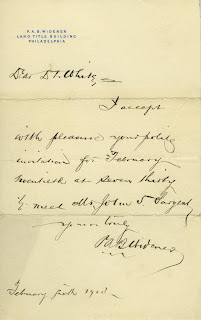Perhaps you have been embarrassed by your mother dragging out the family photo album of your blubbering baby years, every time the guests come.
Or perhaps you have kept trinkets of childhood memory stored in the attic, just for the sake of nostalgia.
Lee Harris, a bus driver who was born in New Jersey 1940 and lived with his wife as a New York City bus driver through the 1970s-, chose to save memorabilia of his life and donated his treasures to the Anacostia Community Museum in 2003.
As I began to process the Lee Harris Papers, I found that a good part of the collection was meticulously labeled (much to my delight), the photographs painstakingly wrapped with non-archival tape and plastic (much to my dismay). The labels were invaluable; needless to say, the plastic had to go. The wrappings did, however, convey how precious these items had been for their owner.
Lee Harris lived in a turbulent stage of American history, through World War II, the Cold War, the civil rights movement, the Vietnam War, etc. As activists and politicians elsewhere were struggling to orchestrate the nation, Lee Harris documented events in his own life that fill in the gaps of this "schoolbook" history – namely, the birth and death of family members, graduation ceremonies, military service, marriage, vacations, and community activities. His individual perspective gives us insight into what might be called the “typical” American experiences of the time.
It is surprisingly easy to forget that the larger stream of historical events is always occurring among the milieu created by individuals, whose lives intersect with these events in varying degrees. As I was going through the documents, I encountered a carefully preserved signed photograph of an astronaut, a news article of John F. Kennedy's assassination, and Lee Harris’s participation in a community salute to Martin Luther King Jr. However, those were the only materials that hinted anything about the major “current events” of his time. I was instead more struck by the level of detail on the labels at the back of the family photographs, and realized that those details were precisely what Lee Harris had deemed worthy of preservation, over anything else.
While studying history in college and interning in the archives, I have learned that often the silences speak out as much as the remaining words and images. Besides the significant lack of mention in the Lee Harris Papers about what we would now think of as historical events, there was hardly any documentation on his career either. Considering the level of detail that he goes in with other aspects of his life, why would he choose to ignore the 30 years or so of his work? Is this another indicator of the centrality of family events for Lee Harris?
Be it out of interest in history of 1940-70s America or out of pure curiosity, I hope that someone will take the time to muse over and interpret these fragments of a seemingly anonymous life. You may see the stalwart figure of a young African American man stepping from Boy Scouts to the military, a travel-lover, or a loving family with strong bonds. You may even be inspired to start accumulating a collection yourself - how would your own life history be defined, half a century later? (And if you have long-term preservation plans for your collection, please do label them for a happy archivist!)
Images: (Top left) Lee Harris standing on a sidewalk in Manhattan, New York.
(Below right) Lee Harris sitting on mother’s lap at the home of his grandmother.
Anna Wada
Anacostia Community Museum Archives Intern
(Here is the translated version for Japanese readers)
*****************************************
リー・ハリス:
1940年、ニュージャージー州に住むアフリカ系アメリカ人夫婦のもとに生まれる。妹が生まれた後ニューヨークへ引っ越し、母親に手を引かれて教会へ行ったり、父親お手製のおもちゃの銃を持って道端で遊んだりと、伸びやかな子供時代を過ごした後高校を卒業。短い間軍事訓練を受けた後結婚し、バスの運転手として働き始める。引退後は妻と共に元気に警察官の体験トレーニングを受けている。
若かれし頃のリー・ハリスを中心とした、ハリス一家の日常を集めたコレクションがアナコスティア・コミュニティ博物館に寄贈されました。1884年の祖母の写真から2001年の旅行の記録まで、主に1940~70年代の記録が残っています。生まれた時から子供時代、高校卒業、結婚、そして引退後の活動の記録はひとつひとつ丁寧に包装され、簡単な説明が添えられています(包装は長期的な保存のために全て剥がしました。プラスチックを剥がす度に彼に申し訳ない気持ちでしたが…)。
1940~70年代の歴史、と聞くと第二次世界大戦や冷戦に関係する政治家の判断や軍部の動き、犠牲者の話等が思い浮かぶかもしれません。リー・ハリスはこれらの歴史的な流れと同時代に生きつつ、最終的に自分や家族の日常の写真・文書のみを保存することにしました。稀にケネディ暗殺の新聞記事や、ニューヨークで行われたキング牧師の演説のパンフレット等が混ざっていますが、やはりコレクションのほとんどは彼自身の古い写真です。また、家族の出生証明書、子供の頃大切にしていた本や、軍事訓練を受けた時のマニュアル、そして引退の4年前に自分自身に贈った「引退おめでとう!」カード等の思い出の品も入っています。
所謂「教科書的な歴史」では大きな流れに目を向けがちですが、誰か一人の人生を辿り直してみることで歴史が何層にも分かれていることが見えて来ると思います。
アナコスティア・コミュニティ博物館のアーカイブには、展示品以外にもこのようなアフリカ系アメリカ人の文化、そしてコミュニティというテーマ全般の歴史を伝えるための個人や団体の記録が大事に保管されています。興味がある方は、博物館にお越しの際に是非展示だけでなくアーカイブスも覗いて見て下さい。ウェブサイトに掲載されている写真や展示品は、コレクション全体の氷山の一角だということがよく分かります。
























